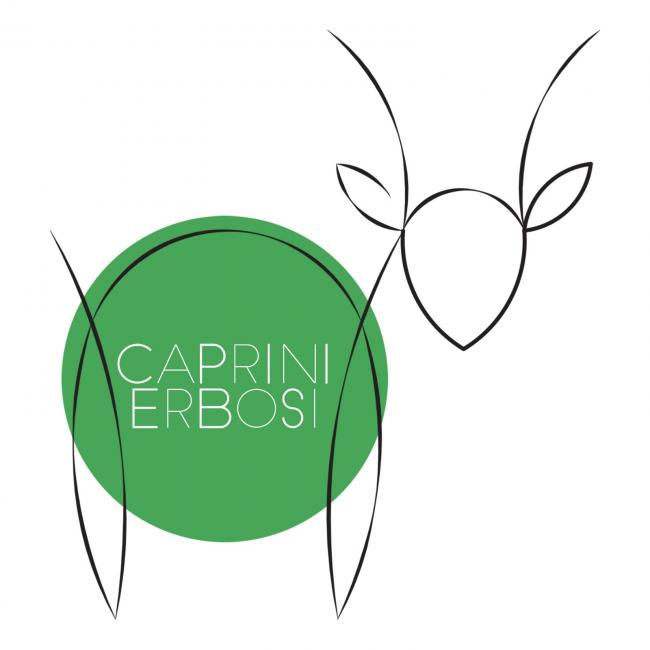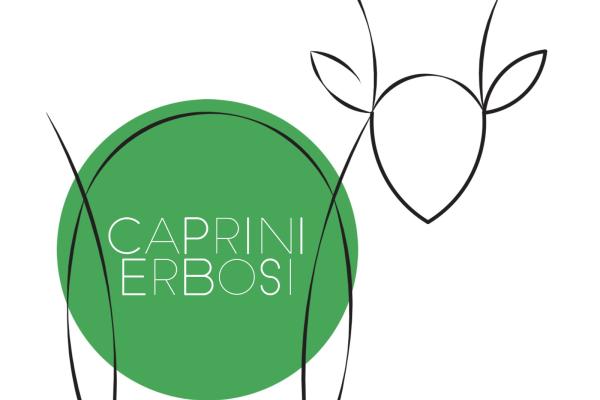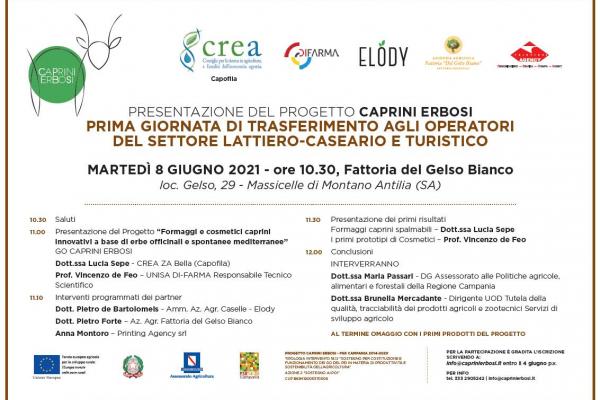Innovative goat cheeses and cosmetics based on officinal and spontaneous Mediterranean herbs

The project aims developing innovative dairy and cosmetic products based on goat milk (increasingly appreciated by the consumers for its properties) and enriched by the compounds extracted from the herbaceous typical biodiversity of the Campania region, both spontaneous herbs, historically appreciated in the area, and the officinal ones, in intensive eco-sustainable cultivation. The aims converge in the enhancement of the existing supply chain, and the creation of a new one, which actively could valorise the regional plant and animal biodiversity, as well as the diversification of the dairy offer, which suffers from national and foreign competition.
Vegetable rennet cheeses from wild herbs: Wall germander showed excellent milk clotting properties and good dairy yield; Yellow bedstraw has confirmed its properties; Common nettle showed properties linked to early summer flowering. The protocols for 3 types of cheeses obtained from these vegetable coagulants are ready: fresh spreadable, caciotta and semi-cooked cheese
Cheeses enriched in natural extracts: the protocols for the production of 3 types of cheeses added with essential oils from aromatic and medicinal plants have been developed: fresh spreadable, caciotta and cacioricotta cheese. The evaluation of the antioxidant power showed that the oils of the herbaceous species used improved the content of total polyphenols in the cheeses, increasing the antioxidant power
Cheeses enriched "in vivo": the aromatic spontaneous plants, domesticated and cultivated in a protected environment according to an innovative protocol, have fully expressed their properties. Naturally hayed and given goats as feed supplementation, they showed an increasing acceptability by the goats from Thyme, Marjoram, Basil to Lemon Balm (ingestion between 2.5% and 5.0% of the total DM), and were able to improve the antioxidant properties of Caciotta cheese
Forage species rich in antioxidants: the “Commerciale” cultivar of Hedysarum coronarium showed the best performance in an optimal water regime (80%), while the Bellante cv proved to be more suitable for a stress water regime (30%), with a trend to higher content of total antioxidants, useful information in choice of cultivars with a view to climate change (reduction in rainfall)
Cosmetics from goat's milk whey: prototypes of three cosmetics, ≃100% natural, were created (hand cream, body cream and firming cream), starting from concentrated goat's milk full whey, enriched with oils extracted from three Mediterranean plants, lavender, broom and lemon; highly appreciated for their texture and great absorption capacity by the skin, female consumers underlined the idea of eco-sustainable reusing of the full whey
Smart packaging: prototypes of smart packaging based on 75% beeswax, 20% extra virgin olive oil and 5% straw have been created for the cured cheeses, and 75% beeswax and 25% of evoo for spreadable cheeses.
The activities move on 5 lines:
- development of dairy technologies for Veg goat cheeses, based on the use of wild herbs (other than thistle) as rennet
- production of goat cheeses:
a) enriched with extracts obtained from officinal herbs, typical of the area, with functional properties
b) naturally enriched, through feeding the goats, also benefiting their welfare
- prototypes of a cosmetic line based on goat's milk whey and "functional" essential oils extracted from typical species of the area
- creation of eco-sustainable packaging
dissemination of production models to stakeholders and consumers.
The market, both national and European, is growing in demand for goat milk products, thanks to the nutritional and functional properties of this milk. The profile of fatty acids, the digestibility of smaller fat micelles and the composition of amino-acids, friendly to consumers intolerant to cows' milk proteins, make it a product increasingly appreciated. Campania region, characterised by the largest number of production units (346) in the national dairy sector, has a long tradition of cow’s and sheep and goat dairy products, but is struggling to offer innovation in goat cheese.
Today’s consumer, more informed, demands for a good and healthy food, able to contribute to his/her well-being, new but still able to carry the link with the territory.
The Campania’s territory is characterized by a rich floristic biodiversity, typical of the Mediterranean area, with officinal species cultivated and other spontaneous, whose properties are almost forgotten. It is felt the need to preserve the ancient know-how related to them, and to actively valorise the spontaneous species, some with renneting properties.
Other species, aromatic, known in the popular medicine for their healthy properties, natural source of bioactive components, represent the core business of companies processing 1st range vegetable products.
Whey derived from the cheese-making process is still an important cost for the dairies for its disposal, and the demand for whey as a raw material is too low. The need to solve this problem has stimulated the scientific research to see it as a resource, able to create a significant profit.
Two supply chains with great potential, asking for innovation.
Goat's milk technologies and wild herbs from Campania with renneting power
This innovation consists in the development and validation of technologies for the production of goat cheeses with vegetable coagulants, to be used as an alternative to animal rennets, through the use of spontaneous Campania herbs other than thistle and artichoke.
The result consists of 3 technological flow-charts of goat's milk cheeses with vegetable rennet: a. fresh spreadable goat cheese, caciotta cheese and semicooked cheese (aged 6 - 9 months).
Technological sheets of 3 types of goat cheeses will be developed, which contemplate the addition of essential oils extracted from officinal plants, identified and studied for their aromatic and nutraceutical properties, e.g. their antioxidant properties. In parallel, milk from goats fed with the same herbages will be processed in cheesemaking, for an "in vivo" enrichment of the milk and a contribution to animal welfare.
Three types of results are expected: a) optimal extraction method of oils / extracts with functional action from plants; b) sustainable models of nutraceutical forage irrigation regime; c) technological sheets of cheeses enriched with extracts and oils with functional action and from targeted nutrition.
The innovation consists in prototypes of a Body line of cosmetics, based on goat whey, from the cheese processing of rennet coagulation (from waste to resource), and essential oils and herbs of the Mediterranean, object of study, able to increase the properties of the main ingredients (exfoliating, emollient, disinfectant and renewal). The products will be ecologically and economically sustainable, as well as 100% natural. The Body line includes 3 products: body lotion, firming body cream, hand cream.
The development of the prototypes of these products will allow the introduction on the market of cosmetics with a strong link with the territory, the reduction of the volume of whey to be disposed of, and the reduction of the relative costs for dairies.
Goat cheese enriched by feeding herbage rich with functional compounds
The innovation consists in the identification of fourages and palatable species by goats and in the consequent formulation of a diet that contains fodder and aromatic species rich in bioactive compounds, capable of enriching goat's milk. The cheeses produced through this diet will be naturally richer in functional compounds, for the benefit of consumer health. The cultivation of fodder and aromatic species will be improved in terms of irrigation management, as far as eco-sustainability and optimization of the content in bioactive compounds.
Cultivation models of nutraceutical forage and aromatic species, with sustainable patterns of irrigation regime.
Production models of flavored aromatics, wilted for the production of pelleted feed.
Cheesemaking process of enriched cheeses starting from feeding goats with fodder and aromatic species rich in bioactive compounds.
| Titolo/Descrizione | Url | Tipologia |
|---|---|---|
|
Sito web del progetto
|
Sito web
|
|
|
Brochure con i risultati del progetto
|
Materiali utili
|

